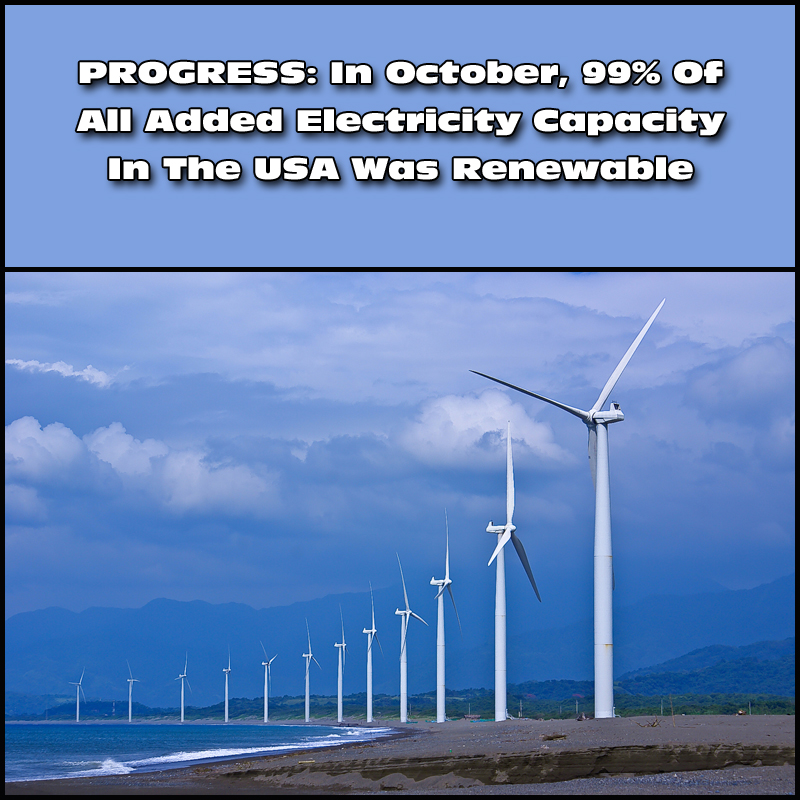 Even though the United States has not tacitly agreed to cooperate with the rest of the globe's industrialized nations in a massive effort and pledge to reduce worldwide carbon emissions under the Kyoto Protocol, the nation does have something it can boast about. The federal Office of Energy Projects (OEP), under the auspices of the Federal Energy Regulatory Commission, reported recently that over 99 percent of all new electricity capacity generated in the nation came from renewable resources.
Even though the United States has not tacitly agreed to cooperate with the rest of the globe's industrialized nations in a massive effort and pledge to reduce worldwide carbon emissions under the Kyoto Protocol, the nation does have something it can boast about. The federal Office of Energy Projects (OEP), under the auspices of the Federal Energy Regulatory Commission, reported recently that over 99 percent of all new electricity capacity generated in the nation came from renewable resources.
The United State's ever increasing reliance on biomass, geothermal, hydroelectric, solar and wind power renewable resources are “to blame” for this claim. The OEP reports that 12 new solar units pushed out an impressive total of 504 megawatts of power, while four new biomass units produced an amazing 124 megawatts. Two new wind generators made 66 megawatts. The balance of the nation's electrical capacity, nearly one percent, was provided by oil, which accounts for a mere five megawatts, a drop in the bucket by any standards.
“As the threats posed by climate change grow increasingly more dire, renewable energy sources have clearly become a viable alternative to fossil fuels as well as nuclear power,” said Ken Bossong, Executive Director of the SUN DAY Campaign. “Accordingly, efforts by some at the state and national levels to roll back support for these sources are clearly misguided.”
 Even though the United States has not tacitly agreed to cooperate with the rest of the globe's industrialized nations in a massive effort and pledge to reduce worldwide carbon emissions under the Kyoto Protocol, the nation does have something it can boast about. The federal Office of Energy Projects (OEP), under the auspices of the Federal Energy Regulatory Commission, reported recently that over 99 percent of all new electricity capacity generated in the nation came from renewable resources.
Even though the United States has not tacitly agreed to cooperate with the rest of the globe's industrialized nations in a massive effort and pledge to reduce worldwide carbon emissions under the Kyoto Protocol, the nation does have something it can boast about. The federal Office of Energy Projects (OEP), under the auspices of the Federal Energy Regulatory Commission, reported recently that over 99 percent of all new electricity capacity generated in the nation came from renewable resources.
The United State's ever increasing reliance on biomass, geothermal, hydroelectric, solar and wind power renewable resources are “to blame” for this claim. The OEP reports that 12 new solar units pushed out an impressive total of 504 megawatts of power, while four new biomass units produced an amazing 124 megawatts. Two new wind generators made 66 megawatts. The balance of the nation's electrical capacity, nearly one percent, was provided by oil, which accounts for a mere five megawatts, a drop in the bucket by any standards.
“As the threats posed by climate change grow increasingly more dire, renewable energy sources have clearly become a viable alternative to fossil fuels as well as nuclear power,” said Ken Bossong, Executive Director of the SUN DAY Campaign. “Accordingly, efforts by some at the state and national levels to roll back support for these sources are clearly misguided.”
In a decidedly responsible move forward by acting alone outside the auspices of the United Nations, the nation's current administration seems committed to adhering to and even surpassing the emission cutbacks called for by the Kyoto Protocol. The White House website says that President Barack Obama has taken “unprecedented action to build the foundation for a clean energy economy, tackle the issue of climate change, and protect our environment.”
Obama and Vice President Joe Biden have created a comprehensive plan called “New Energy for America”, which will not only reduce the nation's carbon footprint, but will also help create five million new jobs by investing $150 billion over the next ten years to jolt private companies to join in on the plan to build a clean energy future. The plan includes putting one million more hybrid vehicles on America's roads by 2015, and implement an economy wide cap-and-trade program that hopes to reduce greenhouse gas emissions by a full 80 percent by 2050.
The electric vehicles we ride in and drive are only as green as the power source used to generate their electricity, so this is certainly good news.